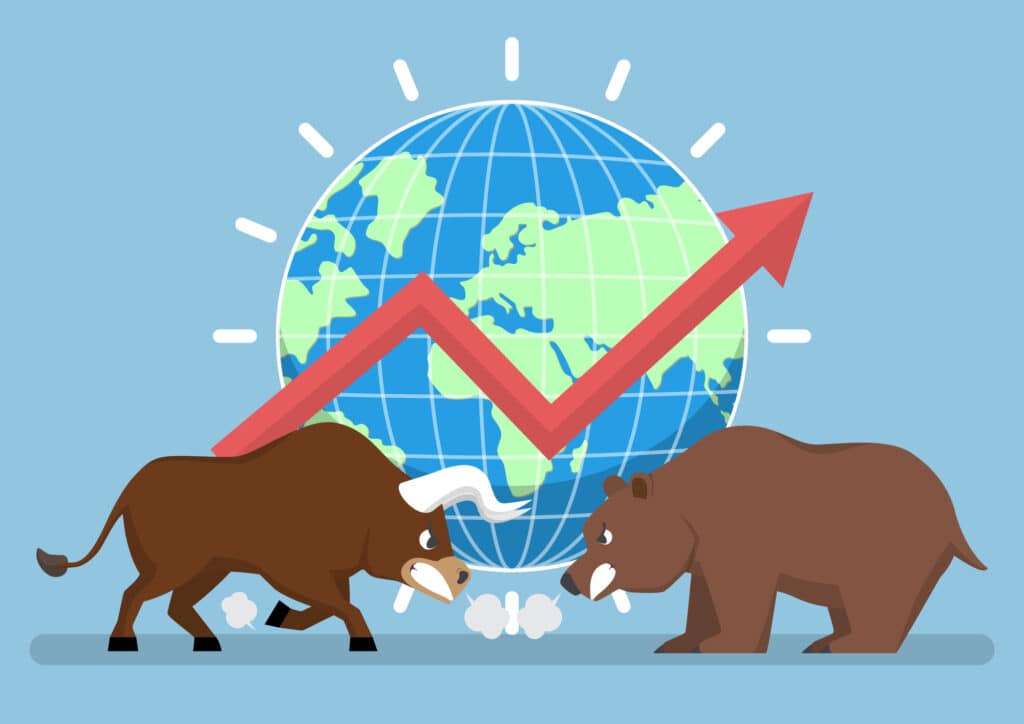The Crypto market is not all stable and fluctuates almost daily. Bull and bear are terms that specifically define stock markets' upward or downward performance. But, how are these terms used for the crypto market?
Simply put, bull and bear markets define the general direction of the crypto market. If the market swings upward or downward by at least 20 percent, the fluctuations are either bull or bear. A rising market is called a bull, while a declining market is called a bear.
Now that we have established what the terms "bull" and "bear" mean, we can now move forward to understand the differences between bull vs bear crypto markets and how traders can handle both.

Bull Market
When the investor's sentiments are positive and the market rises, it is called a bull market. Bull markets are associated with favorable economic conditions. Bull refers to high employment levels and a strong economy in traditional markets.
But let's talk about a bull run in the crypto market. When it comes to crypto, a bull run occurs when there is an approximate increase of 40 percent in the price of cryptocurrencies within a span of one or two days. Since crypto markets are smaller than conventional stock markets, there is more volatility.
Are you wondering now why these markets are called bull markets? There is a simple answer to this question. Bull markets are called so because its horns are facing upward if you've ever observed a bull. When a bull fights, it uses upward horns. The horns correlate to optimism that one's assets will continue to rise in the crypto market.
Investors start a bull market. When the demand exceeds the supply, you will find a bull market shifting to a bear market. Simply put, when investors feel that the prices of cryptocurrencies will rise, they start purchasing more assets in hopes of getting high returns. When more and more investors begin buying cryptocurrencies, prices rise. Besides the investors ' optimism, some other factors create bull markets.
These factors include trending culture, social media, and events threatening fiat money. A great example would be the covid-19 pandemic when the value of money dropped, and that was when people started investing in crypto even more.
Bear Market
When the value of cryptocurrency falls over 20 percent, and there are more chances of it continuing to fall, a bear market is created. In a bear market, the prices continue to dip to new lows. The downward trend is associated with a bear's claws facing downward in contrast to a bull's horns facing upward.
In traditional financing, a bear market is characterized by poor economic conditions and high unemployment rates. When it comes to the crypto market, the price of cryptocurrencies hit rock bottom. This is when investors aim to purchase assets, but when the price increases again are uncertain, making the investment in bear markets a huge gamble.
Negative sentiments towards crypto trading lead to lower trading volume, resulting in the creation of bear markets. People start losing confidence that the decreased prices will ever recover and end up selling their assets at a lower price in fear and anxiety of the prices dropping further.
Generally, the bear market emerges when people aren't talking about crypto trading on social media or a widespread mistrust of cryptocurrency.

Bull vs. Bear Crypto Market
In contrast to the stock market, cryptocurrency is affected differently by bull and bear markets. In crypto trading, the feedback that investors give influences the market. Moreover, crypto markets move a lot faster in either bull or bear direction. You won't find cryptocurrency in a bull or bear market for more than a month. There are even times when the market prices fluctuate within days.
Let's now look at the significant differences between the bull vs. bear crypto market:
- The most significant difference between a bull and bear crypto market is the ratio between demand and supply. In a bull market, demand is higher than supply. More people want to invest in crypto while few are willing to sell. The increased demand drives the prices to go higher than before. On the other hand, in bear markets, the demand is less, with excess supply causing the prices to drop.
- The current stock price will indicate whether the crypto market is bullish or bear. Higher prices mean a bull market with increased confidence in incoming prices. Similarly, lower prices indicate a bear market with low confidence in the incoming market prices.
- The liquidity of prices is higher in bull markets than in bear markets as the investors lack confidence. In bull markets, the cost of transaction is lower with high returns.
How to Handle Bull Markets
As soon as you spot a bullish market trend, it's best to invest in crypto before the market reaches its peak. Once the prices reach the highest point, you can sell your assets to maximize profit. Generally, bull markets last longer, but if you sense an emergence of a bear market, it is best to move your savings into actual cash or any other form of saving. It will allow you to buy back the cryptocurrency when the bull market starts again.
How to Handle Bear Markets
Bear markets are full of risks, but the silver lining is the lower prices of the cryptocurrency. Even if the market prices are declining, you can hope that they will rise again so you can earn a high return on investment.
You can also choose an alternate method to sell your assets at the start of a bearish market and repurchase them as the prices decline further. You can then sell them after a bull market emerges and reaches its peak. But the risks of not knowing when a bull market will appear again will always linger.
Conclusion
Now that you know the differences between bull vs bear markets and how to handle them, you can adopt different strategies to earn maximum profit from both markets. Bull markets offer better opportunities for earning profits in general. You have to monitor the trends closely and make transactions wisely if you don't want to deal with losses with bear markets.
The post Bull vs Bear Crypto: What's the Difference and How to Handle Both? appeared first on Fat Pig Signals.
https://ift.tt/VLZEijF

Nenhum comentário:
Postar um comentário